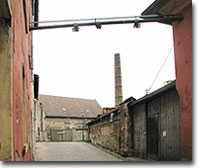![]()
![]()
April 19
Woerlitz - Dessau
April 20
Dessau - Aken
April 21
Aken - Barby
April 22
Barby - Schoenebeck
| Angie Littlefield • Dessau |
Check out the Photo Galleries: 1, 2, 3, 4, 5
Near our hotel in the ancient town of Woerlitz the sign for Street of Graves beckoned us to an area that could have doubled for a street in Terezin. The dilapidated brick buildings, towering chimney and generally decaying street spoke very much of death. We had headed down the Street of Graves twice to search out the synagogue of Woerlitz. No graves – no synagogue. We had found a building that seemed to fit the bill but it was unmarked. The unmarked synagogue and the invisible graves cried out on behalf of those who had gone before. Why was no one in Woerlitz marking their passing?
Architect Walter Gropius moved the experimental school of design he called the Bauhaus from Weimar to Dessau in 1925-26. He brought with him masters of art and design such as Wassily Kandinsky, Oskar Schlemmer, Paul Klee and Lyonel Feininger. We visited the teaching, studio and living quarters of the Bauhaus in Dessau as well as the Masters' quarters nearby. It was amazing to see how pervasive the influence of this relatively short lived group in Germany has been on modern architecture and design.
April 20th, Hitler's birthday, Judy and I decided to visit Jewish sites in Dessau. The glory of the former Cantor's house was lost among graffiti in the somewhat run down area of Dessau. Near to the Cantor's house we took a photo by the monument that commemorated the Jewish presence and suffering in Dessau. The synagogue and graveyard were desecrated November 9, 1938. We found the Jewish cemetery further along the river Mulde but it was walled in with barbed wire on top of a brick wall. An elderly lady had noticed us trying to find our way in and told us that the cemetery was on her walking route but that no one ever went in. She walked around with us quite perturbed that we should want in. A police car driving by slowed down to check us out as we walked along the wall. Finally Judy just opened a metal door and we were in. We were greeted by a wall made up of the remnants of gravestones vandalized on Kristallnacht and then ploughed under by the communists. Ferry System Bridges are rare on the Elbe; ferries are available on demand in many key spots. Where the Elbe's currents are very strong, a pulley system channels the current in such a way as to propel the ferry across to the other side. The pulley is anchored upstream and you see ten or so huge barrel/buoys that move but remain anchored. Cars, large trucks, bicyclists and pedestrians use these ferries at very low cost. Today our driver coming to get us heard about these ladies in black pants who'd come walking the day before to take the ferry. I guess these ferries don't have as much happening as one might think.
We had seen a few of the magnificent storks on their pillar top nests before our photo of the nest near Barby. It doesn't capture, for example, what we saw today as two frisky storks were playing at mating on their huge nest in Pretzien. Where was our camera then? At the ferry stop we saw that in 2007 there were four stork eggs laid in the area of which three storks were hatched. Starting in Riesa we met our driver Wolfgang Barth who not only transferred our luggage forward for ten or so days, but who also acted as tour guide and trip advisor—doing a great job. Wolfgang and his wife run the Ambiente Hotel in Stresa which is directly on the Elbe and next door to a castle. Wolfgang has had many careers and has raised two children. Through him we found out more about life in the DDR and in the unified Germany today. His website is www.ambiente-hotel-strehla.de . Starting in the middle Elbe domain and in the Woerlitz-Dessau Garden Estates we started seeing these wooden huts/towers. At first we thought that these fragile wooden towers were for foresters. Then our driver said they were for hunters—which seemed strange at times as they looked over vast expanses of fields. The many eagles and hawks we saw gliding on the thermals above us seemed more likely hunters. We're still not certain what they are, but, I decided that I would climb one and I did. |
Angie Littlefield | 416.282.0646 | angie.littlefield@yahoo.ca |

 Street of Graves in Woerlitz
Street of Graves in Woerlitz  Bauhaus
Bauhaus  Jewish Dessau
Jewish Dessau

